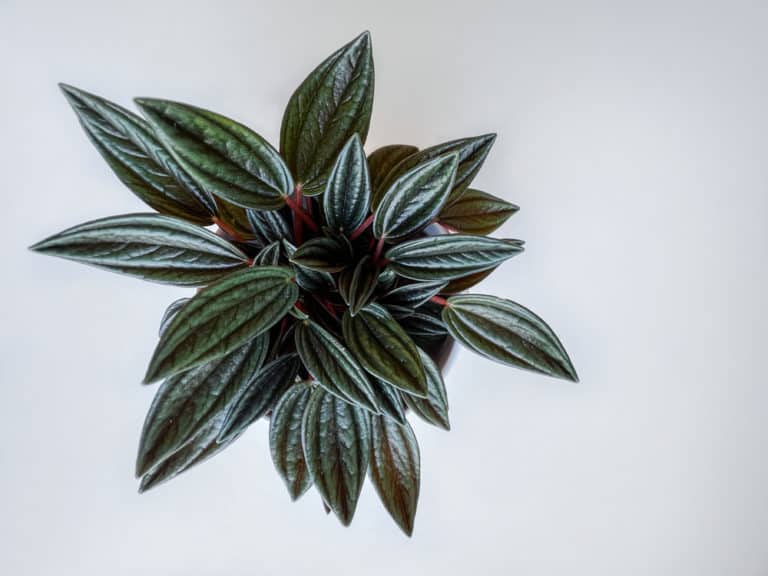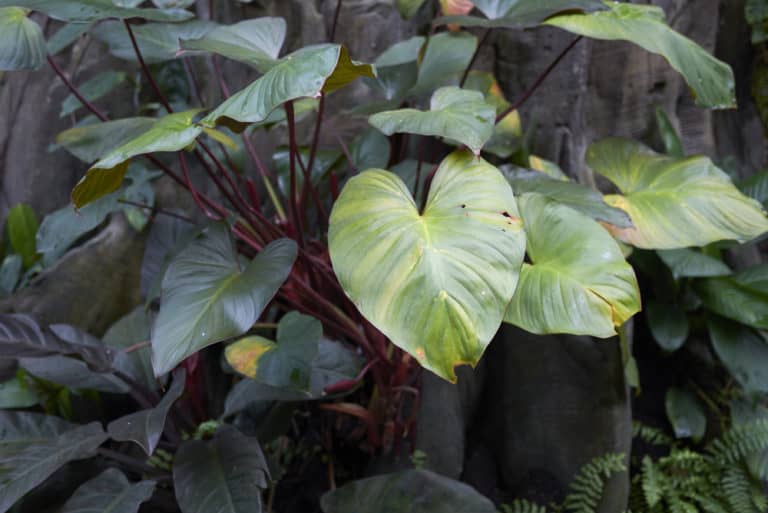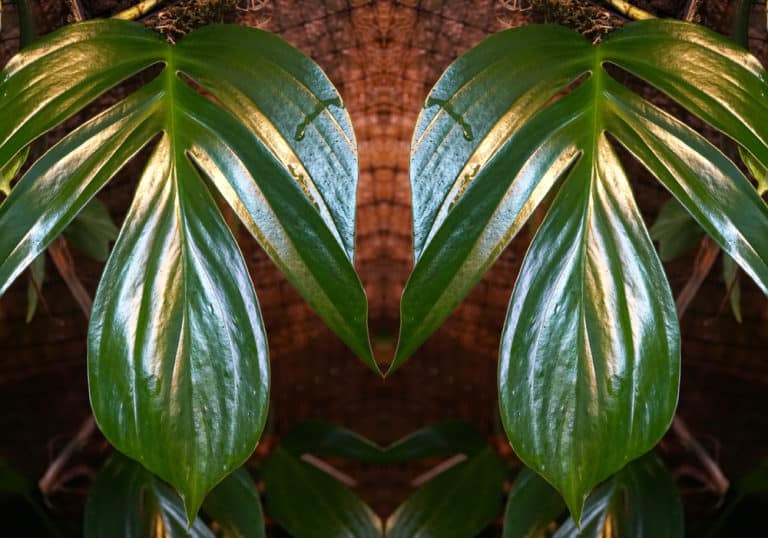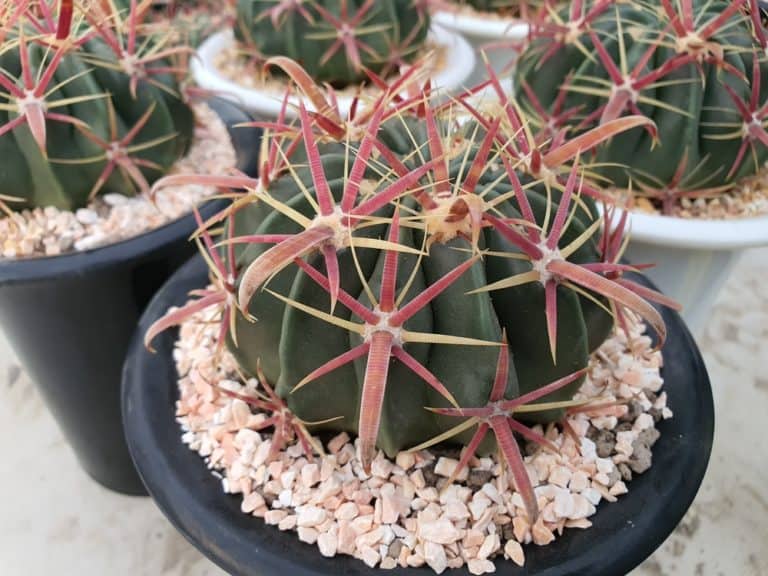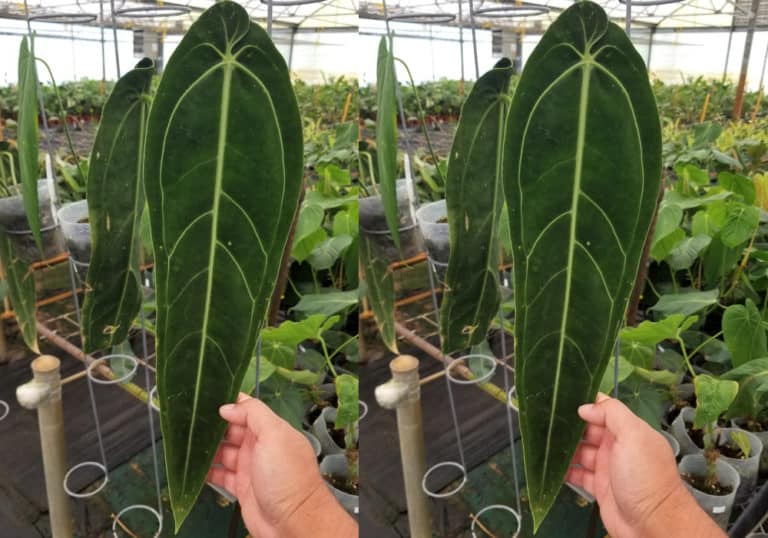Philodendron Erubescens ‘Painted Lady’ Guide Care (2024)
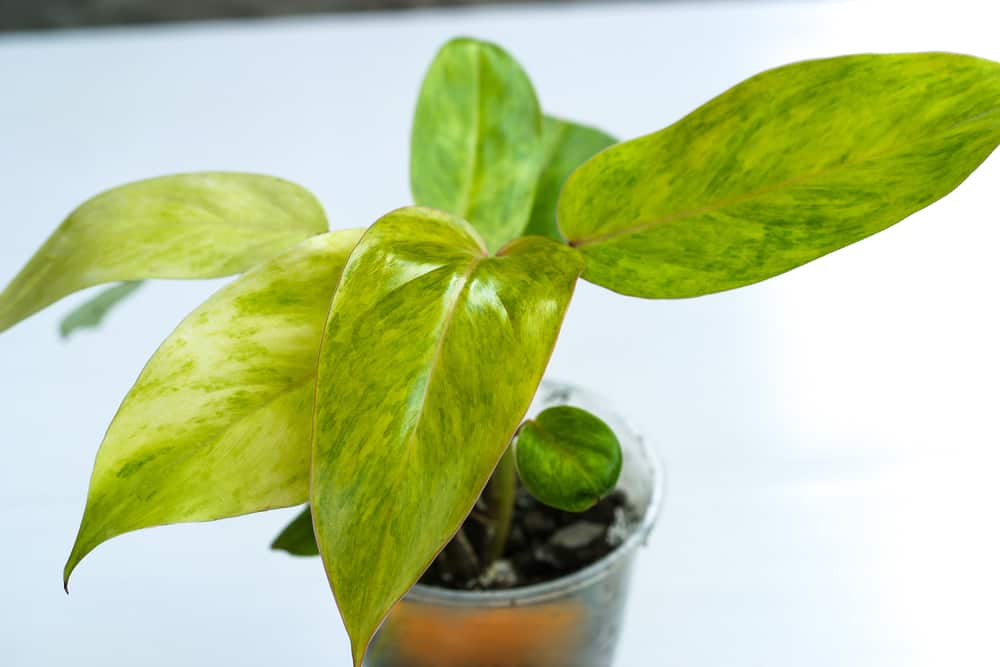
The philodendron painted lady is a gorgeous philodendron cultivar that you might have a bit of trouble finding, but it’s worth looking for!
Painted lady has become a bit of an Instagram star in the past year. It’s got fresh, zippy variegation that’s perfect for modern living.
Add to that its easy-going growing needs, and it’s a clear winner..
| Scientific Name | Philodendron erubescens ‘Painted Lady’ |
| Common Name | Philodendron Painted Lady |
| Light | Bright indirect sunlight |
| Watering | Water if the top half 2 inches of soil are dry |
| Temperature | 65 to 80ºF (18 to 27ºC) |
| Hardiness Zone | 9 to 12 |
| Humidity | 60 to 70% |
| Soil Type | Rich, quick-draining, loamy |
| Soil pH | 6.1 to 7.3 (mildly acidic to neutral) |
| Fertilizing | A balanced feed once a month in spring and summer |
| Repotting | Every 2 or 3 years |
| Pruning | Beginning of the growing season |
| Propagation | Stem cuttings or air layering |
| Toxicity | Toxic to humans and pets |
| Mature Size | 2 to 5 feet as a houseplant |
| Bloom Time | Late spring, early summer |
What’s Unique About Philodendron Painted Lady?
The philodendron painted lady plant was bred in Florida by Robert McColley in the 1970s.
It’s a cross between Philodendron Burgundy and Philodendron Emerald Queen, which are native to the rainforests of Colombia.
Philodendron painted lady plants are distinctive for their bright, citrusy green leaves sprinkled liberally with yellow flecks. The pink stems and petioles add another dimension of color.
Growing philodendron painted lady is not a difficult task, even for a new gardener, making it perfect for a first plant purchase.
It’s also a great plant to grow in a small city apartment, as it is a natural air purifier that will filter formaldehyde from the indoor air.
Philodendron Painted Lady Care
In the tropical rainforests where Philodendron erubescens originates, these understory plants thrive in the filtered sunlight and hot and humid conditions that prevail.
Your philodendron painted lady plant care should be geared towards providing similar conditions.
Good painted lady care involves giving your tropical plant warmth and high humidity while finding it a bright spot out of the full sun.
Light
The equatorial sun shines down brightly on the native rainforests of Philodendron erubescens, but before the rays reach the understory plants they are filtered through the tree canopy.
What this means for philodendron painted lady light requirements is that they need bright light, but need to be kept out of the full sun. That works out to between 10,000 to 20,000 lux.
You can meet those painted lady light needs in a north or east-facing window, or several feet back from a window with a south or west exposure.
In winter, depending on your latitude, you may need to supplement natural light with a plant light.
Watering
Philodendron erubescens is used to a fairly steady supply of water in the rainforest, but the soil drains away most of it fairly quickly. It’s wetter in the summer than in the winter.
You will need to follow the same pattern for your philodendron painted lady watering schedule.
Actually, you don’t need a watering schedule, but rather a soil testing schedule.
Only water painted lady when the top 2 or 3 inches of the soil has dried out. Thoroughly soak the soil and let the excess drain away before setting the pot back in its saucer.
Your philodendron painted lady’s watering needs will slow down in winter when it’s not actively growing. You should be able to wait until the soil has almost completely dried out before giving it a good soak.
Temperature
The temperature in the rainforest home of Philodendron erubescens hovers just below 86ºF (30ºC) during the day, and right around 70ºF (21ºC) at night all year.
In your home, the acceptable philodendron painted lady temperature range is from 65 to 80ºF (18 to 27ºC).
Basically, whatever temperature you feel comfortable in will be a good temperature for painted lady.
You can give her an extra treat in the hot summer by giving her a couple of months in a shady spot on a patio or balcony.
However, don’t wait too long before bringing her back in when fall approaches, as this tropical plant has little temperature tolerance under 55ºF (12ºC).
It definitely has no frost hardiness and will not survive a freeze.
Humidity
Philodendron erubescens is used to humidity between 70 to 80% in the rainforest, so your
philodendron painted lady humidity requirements are fairly high.
The ideal humidity for painted lady is between 60 and 70%, although it might be satisfied with a
humidity level of 40%.
However, if you start to notice brown tips on those gorgeous leaves, you will need to provide something closer to its native environment.
Misting only provides a temporary fix, but you can place a pebble tray filled with water under the pot to help.
Grouping all your plants together can generate their own moister microclimate, and you can always give that a boost with a small humidifier.
Soil
Your philodendron painted lady soil should mimic the soil of the rainforest floor as much as possible.
There, philodendrons grow in a spongy, loose soil with plenty of rotting organic matter. It’s always damp but never soaked.
The best pH level for painted lady is 6.1 to 7.3, or mildly acidic to neutral.
The easiest soil for painted lady is 100% peat moss. You can find this garden staple at most stores, and it will stay loose while retaining a sufficient amount of water.
You could also use a commercial soil mix for your philodendron painted lady; either an aroid or African Violet soil will work well.
Fertilizer
You do not need to use much philodendron painted lady fertilizer, but a moderate amount during its growing season will help with the foliage growth.
A balanced fertilizer ratio of 20-20-20 will work well, although you may choose to use one with a higher ratio of nitrogen to encourage leaf growth.
You can use slow-release granules early in spring, at the beginning of summer, and then finally in early fall. Work them into the soil about 6 inches away from the base of the plant.
Otherwise, use a liquid fertilizer for painted lady once a month in spring and summer. Dilute it to half the recommended strength and apply around the perimeter of the pot or 6 inches from the crown.
Potting & Repotting
Because she’s not a fast-growing plant, you should only need to undertake philodendron painted lady repotting once every 2 or 3 years.
You will know when it’s time for repotting painted lady when roots are growing out of the drainage holes or they have filled up the pot.
Philodendron painted lady doesn’t mind being a bit rootbound, but eventually there will be no soil left!
Only move up one pot size at a time, because if there’s too much soil in relation to the roots the soil won’t dry out as it should. Always be sure that it has good drainage.
Fresh potting soil is a must, as disease can build up otherwise.
Pruning
Philodendron painted lady pruning can be done in spring at the beginning of the growing season.
If you wish, you can cut back stems to encourage bushier growth rather than length.
Just trim a stem right above a node, which will then develop new lateral stems.
However, there’s not much need for cutting painted lady, aside from the normal maintenance tasks of removing dead or damaged leaves and stems.
That should be done whenever it occurs during the year, both to keep your philodendron painted lady looking its best, and discourage disease or pests.
Use sterilized scissors, and wear gloves to protect your skin from the toxic sap.
Propagation
Philodendron painted lady propagation is easily done with stem cuttings or by layering.
To propagate painted lady using stem cuttings, cut 5 inch lengths of stem with at least 1 node and a few leaves.
Cut just below a node, and strip off all but the top leaves.
Put the cuttings in a jar of water, or stick them in a moist growing medium. Keep them in a warm and humid spot out of the full sun, and within a month you should have rooted cuttings.
Air layering is more challenging.
Select a node, and wrap damp sphagnum moss around it entirely, and cover it completely with plastic wrap.
Within a few weeks you should see roots growing within the moss, and you can cut below the node and plant it out.
Also, make sure to check out our in-depth Philodendron prince of orange plant care guide.
Common Problems of Philodendron Painted Lady
The majority of philodendron painted lady problems are simply a result of inadequate growing conditions.
Usually problems with painted lady will show up first in its leaves, and diagnosis is usually pretty straightforward.
Whether it’s insects, disease, or a poor location causing the problem, you should easily be able to restore your philodendron painted lady to full health.
Pests
The best way to deal with philodendron painted lady pests is to wipe down the leaves of your painted lady at least once a month. Use an insecticidal soap or neem oil solution to deter most bugs.
Spider mites are mostly detected through their webs and the little yellow bumps they leave on the leaves. You can rinse them off with a hand-held shower nozzle.
Fungus gnats love damp soil. Use yellow sticky traps for the adults and drench the soil with a hydrogen peroxide solution to kill larvae.
Scale look like small brown bumps on the stems and under the leaves. Scrape them off gently.
Mealy bugs can be found in fluffy groups on the underside of the leaves. Wipe them off with a cotton ball soaked in rubbing alcohol.
Diseases
While painted lady was bred to be resistant to some diseases, she is still susceptible to fungal and bacterial infections caused by too much water.
The most common of philodendron painted lady diseases is root rot, which can develop when the soil is too wet.
When the leaves turn limp and yellow, and the stems are soft, it’s a good bet that the roots are turning black and smelly.
Cut out the affected parts and plant it in fresh soil after disinfecting the pot to kill any remaining fungus.
Leaf spot can be caused by one of several different pathogens. When you start to notice discolorations that spread and kill the foliage, cut off all infected leaves and keep the remaining ones dry.
Growing Problems
Some growing problems are just caused by poor growing conditions. Dealing with those issues should restore your sick plant to good health.
Brown leaf tips are often an indication that the humidity level around your philodendron painted lady is too low for healthy growth.
Brown spots or bleached-out leaves mean that your philodendron painted lady is getting too much direct sun.
If the tips of the leaves are curling up, you’re giving your philodendron painted lady too much fertilizer.
If your philodendron painted lady’s leaves are no longer painted, but rather have turned a solid green, it’s not getting bright enough light.
Toxicity of Philodendron Painted Lady
The painted lady plant is toxic to humans and pets.
The calcium oxalate crystals found in all parts of the plant, including the sap, are responsible for its moderate level of toxicity.
The crystals, or raphides, will pierce skin and internal membranes and cause immediate, intense pain and sometimes rashes or swelling.
For Humans
Because the philodendron painted lady is toxic to humans, care should be taken when growing this beautiful plant.
Adults are not likely to try eating it, but even handling the plant can cause painful rashes. If any gets on your skin, rinse it off immediately.
Children are naturally curious creatures, and can’t be depended on to not try eating anything they get their hands on.
Since they will almost immediately experience pain if they ingest a bit of the foliage, they probably won’t persist.
For a mild reaction, rinse their mouth out and give them a cool treat to dull the pain.
However, a swollen tongue or airways will require a visit to the emergency room.
For Pets
Philodendron painted lady is toxic to most common household pets, including cats, dogs, and rabbits.
If your pet has eaten some of the foliage and is drooling excessively, excessively, wheezing, or vomiting, or has persistent diarrhea, don’t try to deal with it yourself.
Take your pet to the veterinarian as soon as possible to prevent serious complications.
It’s best to prevent such situations by keeping your philodendron painted lady out of harm’s way.
You can plant it in a hanging basket or put its pot on a high shelf where it cannot be reached by the small members of your household.
Philodendron Painted Lady Appearance
The philodendron painted lady appearance is fresh and cheerful, making it an Instagram star.
Its foliage has a simple but snazzy look that is perfect in modern interiors or vintage decor.
Its slow growth rate and climbing habit gives you lots of options on how to use it in your home.
Foliage
The foliage of philodendron painted lady is distinguished by its subtle but perky variegation.
When a new leaf unfurls, it’s a bright neon green, and then as it matures it develops a darker green with an allover splattering of yellow splotches.
You can expect to see leaves at various stages of maturity at the same time for added visual interest.
The petioles and stems are a deep pink, creating a striking contrast with the green-yellow leaves.
The leaves have an elongated heart shape, averaging 7 inches long and 5 inches across.
They have a glossy surface and a leathery texture.
These evergreen leaves need regular cleaning to keep them looking their best and to ensure good photosynthesis.
Flowering
Philodendron painted lady flowering is not usually considered a good thing.
The reason for that is that the flower has a distinctly unpleasant scent.
When blooming does occur, it’s in late spring, but only on mature plants more than 5 years old.
The insignificant white and cream flowers are not only smelly, but also use precious energy that is better spent on growing the gorgeous leaves.
As well, propagation is better done through stem cuttings or layering, rather than the seeds that would result from the flowers.
For all these reasons, it’s recommended that you cut off the flower spikes as they emerge.
Size and Growth
The mature size of philodendron painted lady is about 5 feet when given support to grow. It has a spread of 12 to 18 inches wide.
Philodendron painted lady has a slow growth rate, taking 5 years to reach maturity.
Philodendron painted lady is a semi-vining cultivar and like many philodendrons can benefit from being grown with the support of a sphagnum moss pole.
However, because it is also self-heading, it can be allowed to grow into a big, bushy shrub form as well.
It’s also suited to planting in a hanging basket, although it will not develop long, trailing stems.
Philodendron Painted Lady Fragrance
While the painted lady flower does have a scent, it is not a pleasant one. It is advised that you cut off the flowers before they bloom, especially if you are growing your philodendron painted lady indoors.
Aside from the flowers, there is no philodendron painted lady fragrance.
However, the philodendron painted lady does filter formaldehyde from the air, so it’s a healthful addition to your indoor environment.
Unscented plants like a philodendron painted lady can actually be better, especially in a small space like a city studio apartment where a strong fragrance could be overpowering.
As well, in many public locations plants with no smell are preferred, since some people have a sensitivity to strong scents.
Suggested Uses for Philodendron Painted Lady
Philodendron painted lady is a popular choice for tropical plant fans right now, and with good reason.
Indoors, it can be used in even moderately low-light locations to provide a bright shot of citrus shades.
If you have the room in your bathroom, a philodendron painted lady will love the extra shot of humid air and add some welcome greenery in what’s often a cold space.
Its bright green foliage will stand out against trendy white walls or work well in a vintage 60s or 70s decor.
On a shady balcony, a philodendron painted lady plant will instantly create the vibe of a tropical oasis.
FAQ
What is philodendron painted lady?
The philodendron painted lady plant is a hybrid philodendron erubescens cultivar bred in the 1970s in Florida, with its parents native to the Colombian rainforests.
How to identify philodendron painted lady?
The philodendron painted lady plant has 7 inch heart-shaped leaves that are green with an allover pattern of yellow spatters, growing from deep pink petioles and stems.
How to care for philodendron painted lady?
The philodendron painted lady plant should be grown in bright but indirect light in soil that is watered regularly, in a warm and humid environment.
How to grow philodendron painted lady indoors?
The philodendron painted lady plant can be grown as a potted plant in normal room temperatures, with relatively high humidity and kept out of the full sun.
How to grow philodendron painted lady outdoors?
The philodendron painted lady plant can be grown outdoors as a container plant or in the ground in zones 10 to 12, or as a patio plant in summer in temperate regions.
How fast does philodendron painted lady grow?
The philodendron painted lady plant has a slow growth rate, taking up to 5 years to reach its full size as a potted plant grown indoors.
How tall does philodendron painted lady grow?
The philodendron painted lady plant grows to a full size of 5 feet tall with a spread of 12 to 18 inches at its maturity.
How to make philodendron painted lady grow faster?
The philodendron painted lady plant will grow its fastest when staked with a sphagnum moss pole in a warm, humid environment and bright, indirect light.
How to stake philodendron painted lady?
The philodendron painted lady plant can be staked with a sphagnum moss pole to help it grow upright, although it will also grow well without any additional support.
How to pot philodendron painted lady?
The philodendron painted lady plant should be planted in rich, well-draining soil with plenty of organic matter, in a glazed or unglazed pot with good drainage holes.
How to revive philodendron painted lady?
If your philodendron painted lady plant has dried out completely, you may be able to revive it by setting the whole pot in a pail of tepid water until the soil is saturated.
Why is my philodendron painted lady dying?
Your philodendron painted lady plant may have a bacterial or fungal disease from excessive watering. Cut out the affected parts and replant it in fresh soil.
Why is my philodendron painted lady drooping?
There’s a variety of possible causes for a drooping philodendron painted lady plant. It may be getting too much sun or water, or not enough nutrients.
How cold can philodendron painted lady tolerate?
The philodendron painted lady plant will not tolerate temperatures below 55ºF (12ºC). Keep it out of drafts and away from cold windows and air conditioning ducts.
How to get rid of pests on philodendron painted lady?
Pests can usually be prevented on your philodendron painted lady plant by wiping down the leaves regularly with an insecticidal soap or neem oil solution.
Is philodendron painted lady toxic to cats?
Yes, the philodendron painted lady plant is toxic to cats. If your cat is having difficulty breathing, or has vomiting and diarrhea, take it to the veterinarian.
Is philodendron painted lady toxic to dogs?
Yes, the philodendron painted lady plant is toxic to dogs. If your dog is wheezing, drooling excessively, or has diarrhea or vomiting, have it seen by a veterinarian.
Is philodendron painted lady toxic to children?
Yes, the philodendron painted lady plant is toxic to children. If your child has a reaction involving a swollen tongue or constricted airways, take them to the emergency room.
Is philodendron painted lady toxic to humans?
Yes, the philodendron painted lady plant is toxic to humans. You may develop a rash if exposed to the sap, so wear gloves when handling this plant.
Does philodendron painted lady have a scent?
The philodendron painted lady plant’s rare flowers have an unpleasant smell, so it is recommended that they be cut off. The foliage has no fragrance at all.

